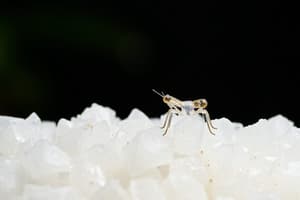Podcast
Questions and Answers
What are carbohydrates primarily composed of?
What are carbohydrates primarily composed of?
Carbohydrates are primarily composed of carbon, hydrogen, and oxygen.
Name the main fuel for mammalian tissues.
Name the main fuel for mammalian tissues.
Glucose is the main fuel for mammalian tissues.
What distinguishes monosaccharides from other carbohydrate types?
What distinguishes monosaccharides from other carbohydrate types?
Monosaccharides consist of one sugar unit and cannot be hydrolyzed into simpler forms.
What is the classification of carbohydrates based on hydrolytic products?
What is the classification of carbohydrates based on hydrolytic products?
Name two important types of polysaccharides and their roles.
Name two important types of polysaccharides and their roles.
What are mucopolysaccharides and provide an example?
What are mucopolysaccharides and provide an example?
Differentiate between aldoses and ketoses.
Differentiate between aldoses and ketoses.
What is the range of sugar units that defines oligosaccharides?
What is the range of sugar units that defines oligosaccharides?
What are the defining characteristics of trioses and how many carbon atoms do they contain?
What are the defining characteristics of trioses and how many carbon atoms do they contain?
Identify the physiologically important hexoses and their significance in the body.
Identify the physiologically important hexoses and their significance in the body.
Describe the conversion of fructose in the body and its relation to glucose metabolism.
Describe the conversion of fructose in the body and its relation to glucose metabolism.
What metabolic disorders are associated with galactose, and what causes them?
What metabolic disorders are associated with galactose, and what causes them?
How does the straight open chain formula of sugars limit our understanding of their reactions?
How does the straight open chain formula of sugars limit our understanding of their reactions?
Explain the significance of glucose as a sugar in the human body.
Explain the significance of glucose as a sugar in the human body.
What role does mannose play in metabolism and where is it commonly derived from?
What role does mannose play in metabolism and where is it commonly derived from?
Describe how the hydration of the aldehyde group in sugars leads to the formation of hemiacetal structures.
Describe how the hydration of the aldehyde group in sugars leads to the formation of hemiacetal structures.
What distinguishes α and β sugars in terms of hydroxyl group placement?
What distinguishes α and β sugars in terms of hydroxyl group placement?
Define an asymmetric carbon atom.
Define an asymmetric carbon atom.
How many possible isomers can a compound have if it contains 4 asymmetric carbon atoms?
How many possible isomers can a compound have if it contains 4 asymmetric carbon atoms?
What characterizes D and L isomers?
What characterizes D and L isomers?
What is the most common form of glucose in solution?
What is the most common form of glucose in solution?
What type of isomerism do α and β anomers exhibit?
What type of isomerism do α and β anomers exhibit?
List two types of isomerism related to monosaccharides.
List two types of isomerism related to monosaccharides.
What percentage of glucose is found in the pyranose form in solution?
What percentage of glucose is found in the pyranose form in solution?
What structural change occurs in deoxy sugars compared to typical monosaccharides?
What structural change occurs in deoxy sugars compared to typical monosaccharides?
What defines amino sugars and provide an example?
What defines amino sugars and provide an example?
Explain the significance of neuraminic acid and its relation to amino sugar acids.
Explain the significance of neuraminic acid and its relation to amino sugar acids.
What is the process that converts an aldose into an aldonic acid, and give an example?
What is the process that converts an aldose into an aldonic acid, and give an example?
Differentiate between uronic acids and aldaric sugars based on their formation.
Differentiate between uronic acids and aldaric sugars based on their formation.
What type of compounds do sugar alcohols derive from and provide an example?
What type of compounds do sugar alcohols derive from and provide an example?
Describe the primary feature of inositols and its significance in human nutrition.
Describe the primary feature of inositols and its significance in human nutrition.
What are glycosides and how are they formed?
What are glycosides and how are they formed?
What characterizes the anomeric carbon in sugar chemistry?
What characterizes the anomeric carbon in sugar chemistry?
What are epimers, and which sugars are the most significant epimers of glucose?
What are epimers, and which sugars are the most significant epimers of glucose?
Define optical activity and its relevance in carbohydrate chemistry.
Define optical activity and its relevance in carbohydrate chemistry.
What is mutarotation, and how does it relate to glucose?
What is mutarotation, and how does it relate to glucose?
Explain what a racemic mixture is in the context of optical activity.
Explain what a racemic mixture is in the context of optical activity.
What is specific rotation, and how is it measured for glucose?
What is specific rotation, and how is it measured for glucose?
How do aldoses and ketoses differ structurally?
How do aldoses and ketoses differ structurally?
Describe the structural configuration of alpha and beta glucose.
Describe the structural configuration of alpha and beta glucose.
Flashcards are hidden until you start studying
Study Notes
Importance of Carbohydrates
- Glucose is the primary fuel source for mammalian tissues.
- Oligosaccharides and polysaccharides are essential components of cell membranes.
- Cellulose is a significant dietary component for preventing constipation, as it stimulates peristalsis.
- Mucopolysaccharides form the basis of connective tissues.
- Heparin is the most important naturally occurring anticoagulant.
- Carbohydrates can bind with lipids to form glycolipids or proteins to form glycoproteins.
Classification of Carbohydrates
- Monosaccharides are the simplest sugars, not further hydrolyzable.
- Disaccharides consist of two sugar units, such as sucrose, lactose, and maltose.
- Oligosaccharides contain 3-10 monosaccharide units.
- Polysaccharides contain more than 10 monosaccharide units; examples include starch and dextrins.
Monosaccharides
- General formula: Cn(H2O)n.
- Classified based on the presence of aldehyde or ketone groups as aldoses or ketoses, respectively.
- Further categorized by the number of carbon atoms: trioses (3 carbons), tetroses (4 carbons), pentoses (5 carbons), and hexoses (6 carbons).
- Pentoses are crucial components of nucleotides, nucleic acids, and many enzymes.
- Physiologically important hexoses include glucose, galactose, fructose, and mannose.
Glucose
- The primary sugar in carbohydrates.
- Results from the hydrolysis of starch, cane sugar, maltose, and lactose.
- Converted into other carbohydrates within the body, such as galactose, ribose, and glycogen.
- The primary sugar transported in blood, utilized by tissues, and a major energy source.
- Elevated blood glucose levels result in its presence in urine, a characteristic of diabetes mellitus.
Fructose
- Found in fruit juices and honey.
- Derived from the hydrolysis of cane sugar (sucrose) and inulin.
- Can be converted to glucose in the liver and intestine, allowing its utilization by the body.
- Accumulates in hereditary fructose intolerance.
- The sugar found in semen.
Galactose
- Formed during the hydrolysis of lactose (milk sugar).
- Can be metabolized into glucose.
- Synthesized in the mammary gland for the production of lactose in milk.
- A component of glycolipids and glycoproteins.
- Errors in galactose metabolism lead to galactosemia and cataracts.
Mannose
- Formed during the hydrolysis of gums.
- A component of many glycoproteins.
Physical Properties of Monosaccharides
- Monosaccharides are colorless, crystalline, and sweet substances.
- They exhibit different forms of isomerism due to the presence of asymmetric carbon atoms.
Isomerism
- Isomers possess the same structural formula but differ in spatial configuration.
- An asymmetric carbon atom is a carbon atom with four unique groups attached.
- The number of possible isomers is 2n, where n is the number of asymmetric carbon atoms.
- Isomers can be categorized as D and L isomers, Pyranose and Furanose ring structures, Alpha and beta anomers, Epimers, and Aldoses and Ketoses.
D and L Isomers
- Determined by the orientation of the -H and -OH groups around the subterminal carbon atom.
- D-series sugars have the -OH group on the right, while L-series have it on the left.
- Most monosaccharides in mammals are in the D-configuration.
Pyranose and Furanose Ring Structures
- Monosaccharides form stable cyclic structures resembling the ring structures of pyran or furan.
- Approximately 99% of glucose exists in the pyranose form in solution.
Alpha and Beta Anomers
- Isomers that differ in the configuration of -OH and -H on carbon 1.
- Alpha anomers have the -OH group on the right in the ring structure, written downwards, while beta anomers have it on the left, written upwards.
Aldoses and Ketoses
- Isomers that differ in the presence of an aldehyde or ketone group.
- Glucose and fructose are examples of aldoses and ketoses, respectively.
Epimers
- Differ in the configuration of -OH and -H on carbon atoms 2, 3, and 4 of glucose.
- Important epimers of glucose include mannose (epimerization at carbon 2) and galactose (epimerization at carbon 4).
Optical Activity
- The ability of a compound to rotate plane-polarized light either to the right (+) – dextrorotatory or to the left (-) – levorotatory.
- Plane-polarized light (PPL) is obtained by passing ordinary light through a Nicol's prism (calcium carbonate).
- Specific rotation is the angle of rotation specific for each optically active substance.
- Glucose, with a specific rotation of (+52.5°), is dextrorotatory and therefore called dextrose.
- Fructose, being levorotatory, is called levulose.
- A racemic (or DL) mixture contains equal amounts of dextrorotatory and levorotatory isomers, resulting in no optical activity due to cancellation of the two activities.
- All monosaccharides, except dihydroxyacetone, are optically active due to the presence of asymmetric carbon atoms.
Mutarotation
- The gradual change in the specific rotation of an optically active compound upon standing.
- Fresh α-glucose has a specific rotation of +110°, while fresh β-glucose has +19.5°.
- An equilibrium mixture forms over time with a specific rotation of +52.5°.
- This is due to the opening of the hemiacetal ring formed by the combination of an aldehyde and alcohol group, followed by reformation with altered positions of -H and -OH groups on carbon 1, leading to equilibrium.
Derivatives of Monosaccharides
- Deoxy sugars have a hydroxyl group replaced by a hydrogen atom.
- Amino sugars have the OH group on the second carbon replaced by an amino group (NH2).
- Amino sugar acids are amino sugars with an additional acid group (pyruvic or lactic acid).
- Aldonic acid is formed by the oxidation of the aldehyde group of aldoses to a carboxyl group.
- Uronic acid arises from the oxidation of the primary alcohol group (last carbon) of aldoses to a carboxyl group.
- Aldaric sugar is formed by the oxidation of both the aldehyde and primary alcohol groups of aldoses into carboxyl groups.
- Sugar alcohols result from the reduction of the carbonyl group (aldehyde or ketone) to an alcohol.
- Inositols are sugars derived from the cyclization of sugar alcohols (mostly glucose).
- Glycosides are formed by the condensation of sugars with another compound, which can be another sugar or a different molecule.
Deoxy Sugars
- Examples: Deoxyribose (from ribose), used in DNA; L-fucose (6-deoxy-galactose), present in glycoproteins; 6-deoxy-L-galactose.
Amino Sugars (Hexosamines)
- Examples: Glucosamine (found in hyaluronic acid); Galactosamine (present in chondroitin sulfate); Mannosamine (found in some antibiotics such as erythromycin).
Amino Sugar Acids
- Example: Neuraminic acid (mannosamine + pyruvic acid).
- Addition of an acetyl group to neuraminic acid produces sialic acid (N-acetyl-neuraminic acid, or NANA), where the acetyl group is attached to the N atom of mannosamine.
Aldonic Acid
- Glucose oxidation to gluconic acid.
Uronic Acid
- Glucose oxidation to glucuronic acid.
Aldaric Sugar
- Glucose oxidation to glucaric (saccharic) acid.
Sugar Alcohols
- Examples: Sorbitol (from glucose), mannitol (from mannose), a mixture of sorbitol and mannitol (from fructose).
Inositols
- Cyclic sugar alcohols derived from glucose with nine stereoisomeric forms.
- Considered a member of the B-complex vitamins.
Glycosides
- Compounds formed by the condensation of sugars with another molecule.
- If the second molecule is another monosaccharide, the glycoside is called a disaccharide.
Studying That Suits You
Use AI to generate personalized quizzes and flashcards to suit your learning preferences.




